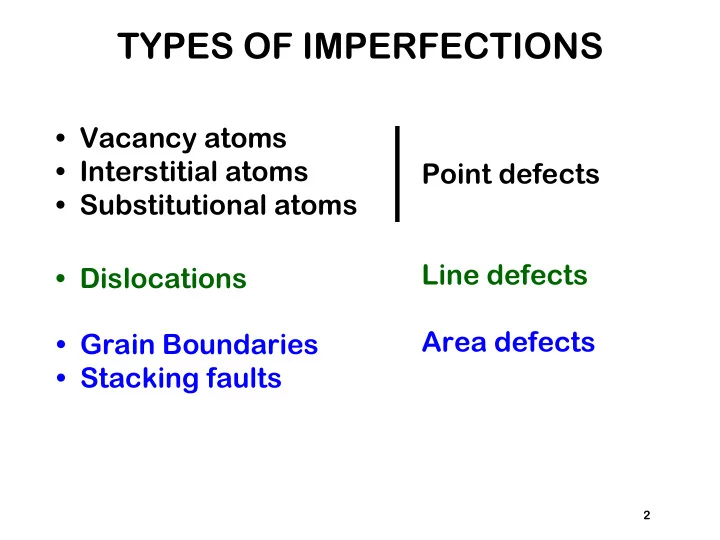

TYPES OF IMPERFECTIONS • Vacancy atoms • Interstitial atoms Point defects • Substitutional atoms Line defects • Dislocations Area defects • Grain Boundaries • Stacking faults 2
No longer perfect: Thermal Energy Lattice points Atom positions Chapter 17 on CD
DEFECTS IN CERAMIC STRUCTURES Frenkel Defect • -- a cation is out of place. Shottky Defect • -- a paired set of cation and anion vacancies. Shottky Defect: Adapted from Fig. 13.20, Callister 5e. (Fig. 13.20 is from W.G. Moffatt, G.W. Pearsall, and J. Wulff, The Structure and Properties of Materials , Vol. 1, Structure , John Wiley and Sons, Inc., p. 78.) See Fig. Frenkel 12.21, Callister 6e . Defect ~ e − Q D /kT Equilibrium concentration of defects • 8
EQUIL. CONCENTRATION: POINT DEFECTS • Equilibrium concentration varies with temperature! Activation energy No. of defects ⎛ ⎞ − Q D N D ⎜ ⎟ = exp ⎜ ⎟ ⎝ ⎠ N kT No. of potential Temperature defect sites. Boltzmann's constant (1.38 x 10-23 J/atom K) (8.62 x 10-5 eV/atom K) Each lattice site is a potential vacancy site 4
MEASURING ACTIVATION ENERGY ⎛ ⎞ − Q D N D • We can get Q from ⎜ ⎟ = exp ⎜ ⎟ an experiment. ⎝ ⎠ N kT • Measure this... • Replot it... slope ND ND 1 ln N N -QD/k exponential dependence! T 1/T defect concentration 5
POINT DEFECTS • Vacancies: -vacant atomic sites in a structure. Vacancy distortion of planes • Self-Interstitials: -"extra" atoms positioned between atomic sites. self- interstitial distortion of planes 3
POINT DEFECTS IN ALLOYS Two outcomes if impurity (B) added to host (A): • Solid solution of B in A (i.e., random dist. of point defects) OR Substitutional alloy Interstitial alloy (e.g., Cu in Ni) (e.g., C in Fe) • Solid solution of B in A plus particles of a new phase (usually for a larger amount of B) Second phase particle --different composition --often different structure. 9
IMPURITIES Impurities must also satisfy charge balance • Na+ Cl- Ex: NaCl • cation Substitutional cation impurity • vacancy Ca2+ Na+ Na+ Ca2+ Ca2+ impurity initial geometry resulting geometry Substitutional anion impurity • anion vacancy O2- Cl- Cl- O2- impurity initial geometry resulting geometry 11
LINE DEFECTS Dislocations: • are line defects, • cause slip between crystal plane when they move, • produce permanent (plastic) deformation. Schematic of a Zinc (HCP): • before deformation • after tensile elongation slip steps 13
Edge dislocation
BOND BREAKING AND REMAKING • Dislocations slip planes incrementally ... • The dislocation line separates slipped material on the left from unslipped material on the right. Dislocation motion requires the successive bumping of a half plane of atoms (from left to right here). • Bonds across the slipping planes are broken and remade in succession. Atomic view of edge dislocation motion from left to right as a crystal is sheared. (Courtesy P.M. Anderson) 15
Screw dislocation
Area Defects • Surface • Grain boundary
AREA DEFECTS: GRAIN BOUNDARIES Grain boundaries: • are boundaries between crystals. • are produced by the solidification process, for example. • have a change in crystal orientation across them. • impede dislocation motion. Metal Ingot Schematic ~ 8cm heat flow Adapted from Fig. 4.10, Callister 6e. Adapted from Fig. 4.7, Callister 6e. (Fig. 4.10 is from Metals Handbook , Vol. 9, 9th edition, Metallography and Microstructures , Am. Society for Metals, Metals Park, OH, 1985.) 16
Twin boundary
OPTICAL MICROSCOPY (1) • Useful up to 2000X magnification. • Polishing removes surface features (e.g., scratches) • Etching changes reflectance, depending on crystal orientation. microscope close-packed planes Adapted from Fig. 4.11(b) and (c), Callister 6e. (Fig. 4.11(c) is courtesy of J.E. Burke, General Electric Co. micrograph of Brass (Cu and Zn) 0.75mm 17
OPTICAL MICROSCOPY (2) Grain boundaries... • are imperfections, microscope • are more susceptible to etching, • may be revealed as polished surface dark lines, surface groove • change direction in a grain boundary polycrystal. Adapted from Fig. 4.12(a) ASTM grain and (b), Callister 6e. size number (Fig. 4.12(b) is courtesy of L.C. Smith and C. N = 2n-1 Brady, the National Bureau of Standards, Washington, DC [now the National Institute of no. grains/in2 Standards and Fe-Cr alloy Technology, at 100x Gaithersburg, MD].) magnification 18
SUMMARY • Point, Line, and Area defects arise in solids. • The number and type of defects can be varied and controlled (e.g., T controls vacancy conc.) • Defects affect material properties (e.g., grain boundaries control crystal slip). • Defects may be desirable or undesirable (e.g., dislocations may be good or bad, depending on whether plastic deformation is desirable or not.) 20
Recommend
More recommend